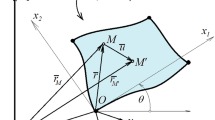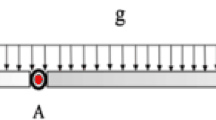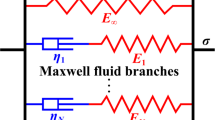Abstract
In this paper, a fully linear method for the kinetoelastodynamic analysis of mechanisms of engineering praxis, characterized by large displacements and rotations (rigid body motion) but small elastic displacements and strains, based on the standard Euler–Bernoulli finite elements is proposed and investigated. The method is a co-rotational approach and relies on the principle to decompose the motion of a mechanism in a series of successive time steps, so small that the linear finite element method can be applied within each step, adding a correction procedure in order to compensate errors resulting from not incorporating the exact (non-linear) beam theory. After presentation of the method, we apply it to test cases well known in the literature and discuss its characteristics.
Similar content being viewed by others
References
Aarts RGKM (2002) SPACAR User Manual
Alvarez J and Rojo J (2002). An improved class of generalized Runge–Kutta methods for stiff problems. Part I: the scalar case. Appl Math Comput 130: 537–560
Alvarez J and Rojo J (2004). An improved class of generalized Runge–Kutta methods for stiff problems. Part II: The separated system case. Appl Math Comput 159: 717–758
Ambrosio JAC and Ravn P (1997). Elastodynamics of multibody systems using generalized inertial coordinates and structural damping. Mech Struct Mach 25: 201–219
Armero F and Romero I (2001). On the formulation of high-frequency dissipative time-stepping algorithms for non-linear dynamics. Part I: low order methods for two model problems and non-linear elastodynamics. Comput Methods Appl Mech Eng 190: 2603–2649
Armero F and Romero I (2001). On the formulation of high-frequency dissipative time-stepping algorithms for non-linear dynamics. Part II: second order methods. Comput Methods Appl Mech Eng 190: 6783–6824
Berzeri M, Campanelli M and Shabana A (2001). Definition of the elastic forces in the finite-element absolute nodal coordinate formulation and the floating frame of reference formulation. Multibody Syst Dyn 5: 21–54
Betsch P and Steinmann P (2002). Frame-indifferent beam finite elements based upon the geometrically exact beam theory. Int J Numer Methods Eng 54: 1775–1788
Caraciolo R and Trevisani A (2001). Simultaneous rigid-body motion and vibration control of a flexible four-bar linkage. Mech Mach Theory 36: 221–243
Chen S and Tortorelli D (2003). An energy conserving and filtering method for stiff non-linear multibody dynamics. Multibody Syst Dyn 10: 341–362
Concalves JPC and Ambrosio JAC (2003). Optimization of vehicle suspension systems for improved comfort of road vehicles using flexible multibody dynamics. Nonlinear Dyn 34: 113–131
Connelly JD and Huston RL (1994). The dynamics of flexible multibody systems: A finite segment approach – I Theoretical aspects. Comput Struct 50: 255–258
Connelly JD and Huston RL (1994). The dynamics of flexible multibody systems: a finite segment approach – II example problems. Comput Struct 50: 259–262
Crisfield M (1996). A unified co-rotational framework for solids, shells and beams. Int J Solids Struct 33: 2969–2992
Crisfield MA and Shi J (1996). An energy conserving co-rotational procedure for non-linear dynamics with finite elements. Nonlinear Dyn 9: 37–52
Cuadrado J, Gutierrez R, Naya M and Gonzalez M (2004). Experimental validation of a flexible MBS dynamic formulation through comparison between measured and calculated stresses on a prototype car. Multibody Syst Dyn 11: 147–166
Devloo P, Geradin M and Fleury R (2000). A corotational formulation for the simulation of flexible mechanisms. Multibody Syst Dyn 4: 267–295
Elkaranshawy H and Dokainish M (1995). Corotational finite element analysis of planar flexible multibody systems. Comput Struct 54: 881–890
Felippa CA, Haugen B (2005) A unified formulation of small-strain corotational finite elements: I. Theory Center for Aerospace Structures CU-CAS-05-02 report
Gasparetto A (2001). Accurate modeling of a flexible-link planar mechanism by means of a linearized model in the state-space form for design of a vibration controller. J Sound Vibration 240: 241–262
Geradin M and Cardona A (1989). Kinematics and dynamics of rigid and flexible mechanisms using finite elements and quaternion algebra. Comput Mech 4: 115–135
Iura M (1994). Effects of coordinate system on the accuracy of corotational formulation for Bernoulli–Euler’s beam. Int J Solids Struct 31: 2793–2806
Jonker JB and Aarts RGKM (2001). A perturbation method for dynamic analysis and simulation of flexible manipulators. Multibody Syst Dyn 6: 245–266
Kanarachos S, Spentzas C (2002) Investigation of the performance of the incremental finite element method of analysis of 2D mechanisms with respect to the stiffness of their arms. In: Proceedings of 4th GRACM Congress on Computational Mechanics 27–29 June Patras, Greece
Kanarachos S, Spentzas C (2004) Analysis of flexible mechanisms using the conventional FEM. In: Proceedings of 1st International Conference From Scientific Computing to Computational Engineering 8–10 September Athens, Greece
Kanarachos S (2004) Analysis of mechanisms using the finite element method. Dissertation, National Technical University of Athens
Kanarachos S (2006) An approximate method for computing kinetoelastic problems. First South-East European Conference on Computational Mechanics 28–30 June Kragujevac, Serbia
Mayo J, Garcia-Vallejo D and Dominguez J (2004). Study of the geometric stiffening effect: Comparison of different formulations. Multibody Syst Dyn 11: 321–341
Meijaard JP (2003). Application of Runge-Kutta-Rosenbrock methods to the analysis of flexible multibody systems. Multibody Syst Dyn 10: 263–288
Negrut D, Haug E and German H (2003). An implicit Runge-Kutta method for integration of differential algebraic equations of multibody dynamics. Multibody Syst Dyn 9: 121–142
Olivetto G and Greco A (2002). Some observations on the characterization of structural damping. J Sound Vibration 256: 391–415
Pascal M (2001). Some open problems in dynamic analysis of flexible multibody systems. Multibody Syst Dyn 5: 315–334
Schiehlen W (1997). Multibody System Dynamics: Roots and Perspectives. Multibody Syst Dyn 1: 149–188
Schwertassek R, Dombrowski S and Wallrapp O (1999). Modal representation of stress in flexible multibody dynamics. Nonlinear Dyn 20: 381–399
Schwertassek R, Wallrapp O and Shabana A (1999). Flexible multibody simulation and choice of shape functions. Nonlinear Dyn 20: 361–380
Shabana A (1998). Computer implementation of the absolute nodal coordinate formulation for flexible multibody dynamics. Nonlinear Dyn 16: 293–306
Shabana A and Schwertassek R (1998). Equivalence of the floating frame of reference approach and finite element formulations. Int J Nonlinear Mech 33: 417–432
Shabana AA (1996). Finite element incremental approach and exact rigid body inertia. ASME J Mech Design 118: 171–178
Shabana AA (1997). Flexible Multibody Dynamics: Review of Past and Recent Developments. Multibody Syst Dyn 1: 189–222
Spentzas KN and Kanarachos SA (2002). An incremental finite element analysis of mechanisms and robots. Forschung im Ingenieurwesen 67: 209–219
Trevisani A (2003). Feedback control of flexible four-bar linkages: a numerical and experimental investigation. J Sound Vibration 268: 947–970
Valembois RE, Fisette P and Samin JC (1997). Comparison of various techniques for modeling flexible beams in multibody dynamics. Nonlinear Dyn 12: 367–397
Vetyukov Yu, Gerstmayr J and Irschik H (2004). The comparative analysis of the fully non-linear, the linear elastic and the consistenly linearized equations of motion of the 2D elastic pendulum. Comput Struct 82: 863–870
Wallrapp O and Wiedemann S (2003). Comparison of results in flexible multibody dynamics using various approaches. Nonlinear Dyn 34: 189–206
Yakoub R and Shabana A (1999). Use of Cholesky coordinates and the absolute nodal coordinate formulation in the computer simulation of flexible multibody systems. Nonlinear Dyn 20: 267–280
Author information
Authors and Affiliations
Corresponding author
Rights and permissions
About this article
Cite this article
Kanarachos, S. Analysis of 2D flexible mechanisms using linear finite elements and incremental techniques. Comput Mech 42, 107–117 (2008). https://doi.org/10.1007/s00466-008-0240-z
Received:
Accepted:
Published:
Issue Date:
DOI: https://doi.org/10.1007/s00466-008-0240-z




